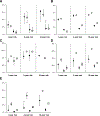Progression of Elderly Onset Inflammatory Bowel Diseases: A Systematic Review and Meta-Analysis of Population-Based Cohort Studies
- PMID: 32142940
- PMCID: PMC7490750
- DOI: 10.1016/j.cgh.2020.02.048
Progression of Elderly Onset Inflammatory Bowel Diseases: A Systematic Review and Meta-Analysis of Population-Based Cohort Studies
Abstract
Background & aims: The incidence of inflammatory bowel diseases (IBDs) in older adults is increasing. We performed a systematic review and meta-analysis to evaluate progression of elderly onset (EO) IBD in population-based cohorts and compared it with adult onset (AO) IBD.
Methods: In a systematic review through June 1, 2019, we identified population-based cohort studies of EO IBD reporting the cumulative risk of hospitalization, surgery, mortality, treatment patterns, escalation, and/or malignancy. Data were synthesized using random-effects meta-analysis as cumulative risk of events at 1 year, 5 years, and 10 years, and compared with data from patients with AO IBD in the same cohorts.
Results: We identified 9 studies, comprising 14,765 patients with EO IBD. In patients with EO Crohn's disease (CD), the cumulative 5-year risk of surgery was 22.6% (95% CI, 18.7-27.2) and was similar to that of patients with AO CD (relative risk [RR], 1.04; 95% CI, 0.80-1.34). Overall exposure to corticosteroids was comparable between patients with EO CD vs AO CD (5-year risk: 55.4%; 95% CI, 53.4-57.4; RR, 0.88; 95% CI, 0.78-1.00), but exposure to immunomodulators (31.5%; 95% CI, 29.7-33.4; RR, 0.62; 95% CI, 0.51-0.77) or biologic agents (6.5%; 95% CI, 5.6-7.6; RR, 0.36; 95% CI, 0.25-0.52) was significantly lower for patients with EO CD than for patients with AO CD. Similarly, in patients with EO ulcerative colitis (UC), the cumulative 5-year risk of surgery was 7.8% (95% CI, 5.0-12.0), similar to the risk for patients with AO UC (RR, 1.29; 95% CI, 0.79-2.11). Overall exposure to corticosteroids was comparable between patients with EO UC vs AO UC (5-year risk: 57.2%; 95% CI, 55.6-58.7; RR, 0.98; 95% CI, 0.91-1.06), but exposure to immunomodulators (16.1%; 95% CI, 15.0-17.2; RR, 0.58; 95% CI, 0.54-0.62) or biologic agents (2.0%; 95% CI, 1.6-2.5; RR, 0.36; 95% CI, 0.24-0.52) was significantly lower for patients with EO UC than for patients with AO UC. Patients with EO IBD appeared to have increased mortality, but not malignancy, compared with the general population. There were few data on comorbidities or adverse effects of medications.
Conclusions: In a systematic review and meta-analysis, we found that patients with EO IBD have a similar risk of surgery as patients with AO IBD. However, patients with EO IBD are less likely to receive treatment with immunomodulators or biologic agents.
Keywords: Aged; drug; natural history; prognostic factor.
Copyright © 2020 AGA Institute. Published by Elsevier Inc. All rights reserved.
Conflict of interest statement
Conflicts of Interest:
Jacob J. Rozich reports no conflicts.
Figures


References
-
- Ng SC, Shi HY, Hamidi N, et al. Worldwide incidence and prevalence of inflammatory bowel disease in the 21st century: a systematic review of population-based studies. Lancet 2018;390:2769–2778. - PubMed
-
- Molodecky NA, Soon IS, Rabi DM, et al. Increasing incidence and prevalence of the inflammatory bowel diseases with time, based on systematic review. Gastroenterology 2012;142:46–54.e42; quiz e30. - PubMed
-
- Vegh Z, Kurti Z, Lakatos PL. Epidemiology of inflammatory bowel diseases from west to east. J Dig Dis 2017;18:92–98. - PubMed
-
- Kaplan GG, Ng SC. Understanding and Preventing the Global Increase of Inflammatory Bowel Disease. Gastroenterology 2017;152:313–321.e2. - PubMed
-
- Burisch J, Jess T, Martinato M, et al. The burden of inflammatory bowel disease in Europe. J Crohns Colitis 2013;7:322–37. - PubMed

